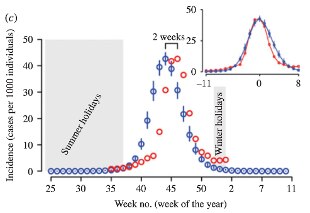Coronavirus: 7,162 new cases with 226,423 swabs and 69 deaths
Share
August 18, 2021 "A
forecast
requires, in addition to knowing the parameters of the natural history of the pathogen, to know in advance and in quantitative terms all the events that may affect the future epidemic dynamics".
This is what we read in the faq published on the ISS website.
"In addition to many others, the social distancing interventions that will be adopted (which and when), the vaccination coverage that will progressively be achieved, the individual behavior of citizens - he adds - may be of particular importance. These factors can be more or less decisive depending on the epidemic being analyzed. In fact, the degree of predictability of an epidemic depends very much on the severity of the infection. In the case of SARS-CoV-2, for these reasons it is currently extremely complex to make predictions on the trend of the epidemic ".
"They can be done instead for viruses whose behavior is known, such as the West Nile virus, transmitted by mosquitoes, which one can reasonably think will have a summer peak, or the flu, which usually has a similar pattern all the years (except in the 2020-2021 season, in which social distancing has significantly influenced the contagion curve, and in the 2009-2010 pandemic season) ", continues the ISS.
Scenario analysis
"In the impossibility of knowing in advance all the events that may affect the future epidemic dynamics, it is possible to formulate various hypotheses (which define the scenario) and analyze the corresponding dynamics. Scenario analyzes are particularly useful for constructing risk estimates, associated with for example to the different levels of intervention that can be adopted (both in terms of imposition and issuing of restrictive measures) or to the different levels of vaccination coverage that will be reached ".
"For example, in the event that different intervention options are under discussion, with scenario analyzes it is possible to identify interventions capable of keeping the epidemic under control with high probability and provide estimates of the epidemic risk (eg in terms of number of cases, hospital admissions and deaths expected over time) associated with interventions that do not guarantee control of the epidemic ", explains the ISS.
"In general,
when evaluating the quality of scenario analyzes retrospectively, it is good not to confuse them with forecasts
. First of all, it is necessary to evaluate well what has been done in reality (for example in terms of interventions), then verify if there are any scenarios that hypothesized what then happened in reality (always in terms of those same interventions) and, if so, make a comparison between observed and simulated epidemics in that specific scenario. It is quite clear that there can only be one scenario compatible with what has been observed.
"" Some scenario analyzes related to SARS-CoV-2 were conducted in April 2020 in anticipation of the reopening. In that case, the possible impact on some parameters (hospitalizations, deaths) corresponding to different degrees of abandonment of the restrictions was estimated. The scenario to be compared with the epidemic observed is the one in which it is assumed:
i) not to reopen schools,
ii) gradual reopening of work activities starting from 4 May (almost complete from 18 May) maintaining high quotas of agile work, especially in essential services,
iii) to maintain limitations on social aggregation activities.
The results of this scenario are extremely consistent with the epidemic observed during the summer of 2020. Obviously, in the scenarios where early reopening or more permissive in terms of social contacts were assumed (eg complete reopening as before the epidemic) the estimate of the impact on the health system was much greater than observed. "
Projections
"A projection is a particular scenario analysis (scenario status quo) and is a useful risk indicator", reads the site. "A projection is usually a useful tool in the short term. When the analysis period is particularly short (so it is not reasonable to expect substantial changes in the parameters in that period), a projection can also be considered as a short term forecast. A example of projection is that on the occupation of hospital beds (in the medical and intensive care area) which is usually presented in the weekly monitoring of the epidemic, in which it is assumed that the RT remains constant and that there are no substantial changes in the other parameters. The method of calculation,based on the renewal equation and epidemiological estimates regarding admissions in the medical and intensive care area. These 30-day projections cannot be interpreted as short-term forecasts. "
"Projections of the SARS-CoV-2 epidemic were also carried out in the summer of 2020 to assess the possible course of the epidemic in the autumn. The mitigation interventions, and in particular the DPCM of November 3, 2020 which established the yellow zones, orange and red, made it possible to greatly limit the impact of the epidemic ", he concludes.

